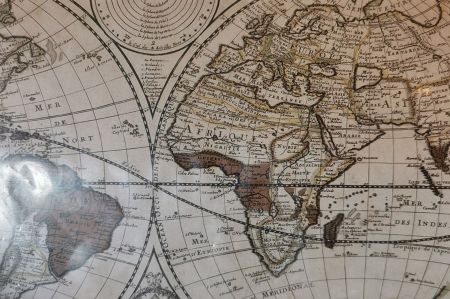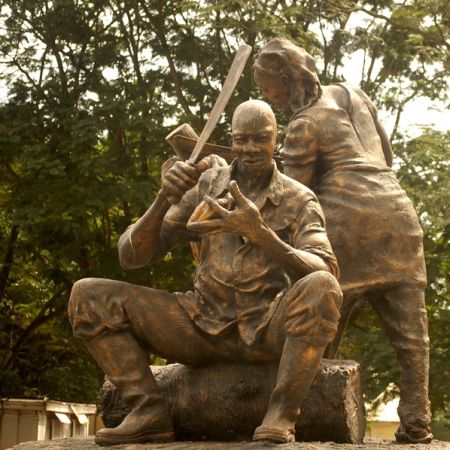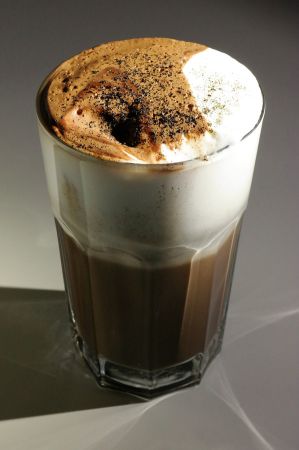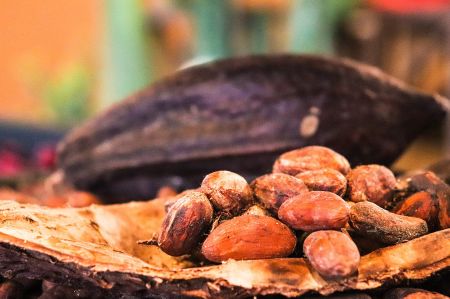Cocoa - a natural product from the tropical rainforest
- Written by Portal Editor
The cocoa plant needs the tropical, humid climate of the rain forest. This became clear to us once again when we looked a little more extensively at a small museum near Amsterdam on the subject of cocoa, the plant cocoa tree and the seeds, and the products made from them.
It has become very easy for us consumers to cover our needs in the supermarket or even in a small specialty shop without much thought, although in the specialty shop you will certainly get at least some marginal information about the product, which can at least make you think and maybe even give you an idea of the connections. Approximately 70% of global cocoa production is not grown in South America, but in West Africa, primarily in the Ivory Coast and Ghana. Only 15% comes from Central America and South America, the actual region of origin of the cocoa. The destruction of tropical rainforests and the associated climate change is not just a problem in South America, quite the opposite, it affects us all, even if many still deny climate change.
Cocoa – one term stands for so many things
 Cocoa is the term that, depending on the context, can refer to a plant, its fruit juice, its seeds or products made from them. The plant in question is usually the so-called cocoa tree with the scientific name Theobroma cacao. Cocoa and chocolate are made from the seeds of the cocoa tree as well as those of other species of the genus "cocoa trees".
Cocoa is the term that, depending on the context, can refer to a plant, its fruit juice, its seeds or products made from them. The plant in question is usually the so-called cocoa tree with the scientific name Theobroma cacao. Cocoa and chocolate are made from the seeds of the cocoa tree as well as those of other species of the genus "cocoa trees".
Only the seed of the cocoa tree is referred to as the cocoa bean and this is what is meant in futures transactions on the stock exchange in cocoa trading. A food on the stock exchange? Our handling of the resources of our earth, better here food is very questionable, isn't it? Ok, in the past cocoa beans were even used as a means of payment. For example, a turkey cost 200 cocoa beans to the Aztecs. Trading in cocoa on the stock exchange may still be ok as long as you don't speculate and bet on it, because then it gets really perverse.
 Today, the largest amount of cocoa per country is produced in the Ivory Coast, but because of the lack of investment security, it is only processed there until the cocoa beans are dried. In plain language, this means that the actual added value does not take place on site but at the large corporations. A cocoa bean contains 54% cocoa butter, 11.5% protein, 9% cellulose, 7.5% starch and pentosans, 6% tannins and colouring components, 5% water, 2.6% minerals and salts, 1.2% theobromine, 1% various sugars, 0.2% caffeine and organic acids and flavourings. It is precisely the large number of ingredients that ensure the wide range of uses.
Today, the largest amount of cocoa per country is produced in the Ivory Coast, but because of the lack of investment security, it is only processed there until the cocoa beans are dried. In plain language, this means that the actual added value does not take place on site but at the large corporations. A cocoa bean contains 54% cocoa butter, 11.5% protein, 9% cellulose, 7.5% starch and pentosans, 6% tannins and colouring components, 5% water, 2.6% minerals and salts, 1.2% theobromine, 1% various sugars, 0.2% caffeine and organic acids and flavourings. It is precisely the large number of ingredients that ensure the wide range of uses.
Products made from the cocoa beans
 Cocoa mass is first extracted from the cocoa bean and cocoa butter and cocoa powder are then made from this. These products are used as ingredients for many foodstuffs and, you will be amazed, they are also used in the cosmetics industry. The drink made from cocoa beans was called "xocóatl" by the Aztecs, after "xócoc" (bitter) and "atl" (water), i.e. bitter water. No comparison with today's cocoa.
Cocoa mass is first extracted from the cocoa bean and cocoa butter and cocoa powder are then made from this. These products are used as ingredients for many foodstuffs and, you will be amazed, they are also used in the cosmetics industry. The drink made from cocoa beans was called "xocóatl" by the Aztecs, after "xócoc" (bitter) and "atl" (water), i.e. bitter water. No comparison with today's cocoa.
The derived word chocolate today describes a solid but easily meltable foodstuff made from components of the cocoa bean and sugar (and possibly butter and vanilla), which was invented in the 19th century and further developed in the 20th century.
 Beverages containing cocoa are made from sweetened beverage powder and are classified as confectionery, whereas real drinking chocolate (also known as cocoa) is classified as cocoa (drink).
Beverages containing cocoa are made from sweetened beverage powder and are classified as confectionery, whereas real drinking chocolate (also known as cocoa) is classified as cocoa (drink).
The juice from cocoa pulp is called “suco de cacao” (cocoa juice) in Brazil. In Central America, such a juice was processed into alcoholic beverages before 1493.
Traces of clay pots found at Santa Ana in the upper part of the Amazon Basin (southeastern Ecuador) show that the plant species Theobroma cacao was present there at least from about 3300 BC. was cultivated. This plant species probably originated there and was later spread across Central America to Tenochtitlan, today's Mexico City.
Drinking chocolate should be a protected term
 In our article: "Cocoa and migration - globalization in the modern world" we had already pointed out the connection between the cocoa harvest - child labour - migration. Unfortunately, the legislature hardly provides any real rules on these issues, the influence of lobbyists on politics is too great. So, it only goes through personal commitment if something is to change. We have often asked in the cafés or restaurants before ordering whether you actually get a cocoa with milk or powder dissolved in water from the vending machine, if with luck you can still taste some cocoa flavour. People in the shops are often surprised at our question at first, but rarely do we actually ask what our concern is. Too seldom is their clear information:
In our article: "Cocoa and migration - globalization in the modern world" we had already pointed out the connection between the cocoa harvest - child labour - migration. Unfortunately, the legislature hardly provides any real rules on these issues, the influence of lobbyists on politics is too great. So, it only goes through personal commitment if something is to change. We have often asked in the cafés or restaurants before ordering whether you actually get a cocoa with milk or powder dissolved in water from the vending machine, if with luck you can still taste some cocoa flavour. People in the shops are often surprised at our question at first, but rarely do we actually ask what our concern is. Too seldom is their clear information:
Of course, we pay attention to sustainability, fair trade and transport with the raw materials we use and of course milk is used for dressing, not water and the cream is actually whipped cream, not from a can. Then cocoa tastes as it should, is healthy and a real natural product.
Please read as well:
De 1800 Roeden – cultural park worth seeing in Amsterdam
Country estates (Villa rusticae) - supply in ancient Roman Empire
-
 Hot Chocolate - delicious drink on the way
Hot Chocolate - delicious drink on the way
Hot Chocolate - delicious drink on the way
Hot Chocolate - delicious drink on the way
-
 Hot Chocolate - delicious drink on the way
Hot Chocolate - delicious drink on the way
Hot Chocolate - delicious drink on the way
Hot Chocolate - delicious drink on the way
-
 Hot Chocolate - delicious drink on the way
Hot Chocolate - delicious drink on the way
Hot Chocolate - delicious drink on the way
Hot Chocolate - delicious drink on the way
-
 Hot Chocolate - delicious drink on the way
Hot Chocolate - delicious drink on the way
Hot Chocolate - delicious drink on the way
Hot Chocolate - delicious drink on the way
-
 Hot Chocolate - delicious drink on the way
Hot Chocolate - delicious drink on the way
Hot Chocolate - delicious drink on the way
Hot Chocolate - delicious drink on the way
-
 Hot Chocolate - delicious drink on the way
Hot Chocolate - delicious drink on the way
Hot Chocolate - delicious drink on the way
Hot Chocolate - delicious drink on the way
https://www.alaturka.info/en/life/culinary/6237-cocoa-a-natural-product-from-the-tropical-rainforest#sigProId9b42fb07be

